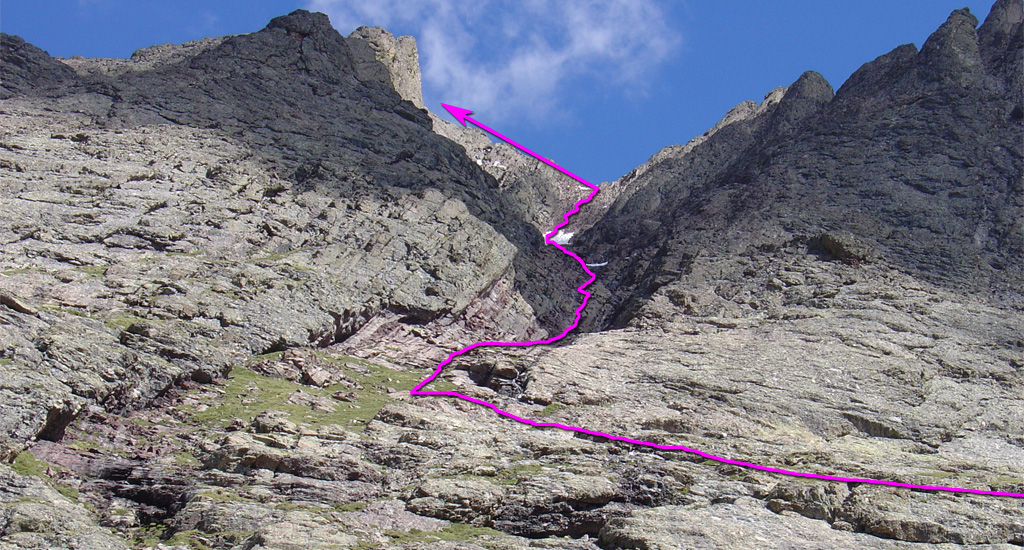From the gate closure at 9,900', cross the footbridge and walk 2.5 miles up the South Colony Lakes (Approach) road to reach a junction -
1. Turn left, cross the river on a log bridge, and reach what used to be the 4WD trailhead before they closed the upper road. Continue past a gate (
2) and walk 3/4 mile to 11,400', where the old road ends and a smaller trail begins. Hike through the bushes and into the trees -
3. Follow the trail as it turns left above 11,600' and parallels the stream below the lower South Colony Lake. Near 11,650', and before the lake, turn left on the trail
towards Broken Hand Pass -
4. Follow the mostly-defined trail as it climbs south up the slope before turning west into rugged terrain, below Broken Hand Pass -
5. Ascend steep terrain to reach a narrow section (Class 3) with few options -
6. Scramble up through the rocks and hike another 200 feet to reach the pass
, near 12,900'.
On the west side of the pass (
7), follow a trail down the steep slope and west to Cottonwood Lake
-
8,
9, and
10. Pass the lake and continue west below Crestone Needle's southwest ridge. After you pass the end/base of this ridge, the view opens up, and you can see Crestone Peak up to the right (north). Follow the small trail as it curves right
and heads toward Crestone Peak's south face.
11 shows the prominent red gully in the middle of the south face, and
12 is a broader view that shows the general route into the gully.
Follow the trail northeast as it climbs into the basin to the right of the base of the gully. You do not have to enter the base of the gully. As seen in
12 and
13, bypass steep rock at the base of the gully by following a small trail to about 12,700'. Turn left and follow cairns up onto the easy rock just east of the gully.
14 looks back toward Crestone Needle, and
15 is the view back over the approach. After a short climb west across the rocks, reach the Red Gully
-
16. Without snow, the rock is stained red from top to bottom. In summer, the lower half will likely have some water running down the center.
Climb directly up the gully by following the red rock -
17. The Class 3 climbing is not too difficult, but there are a few steep pitches, especially if you have to climb around snow in the center. Some of the gully is steep "hiking" on smooth rock. Follow the best rock by occasionally switching from one side of the gully to the other. There are steep sections between 13,000' and 13,500', and then again between 13,750' and the notch at the top of the gully.
18 was taken near 13,600';
19 and
20 show the upper portions of the gully and the steep section below the notch. Above 14,100', reach the (notch
) at the top of the gully -
21 and
22. Turn left and scramble up on conglomerate-rock ledges -
23,
24, and
25. The summit is a short distance away, but it's good to take your time and find the best route up through this semi-exposed area. Depending on your climbing skills, you may find this final pitch to be more difficult than the gully. After the short scramble from the notch, reach The Peak's rugged summit -
26 and
27.



